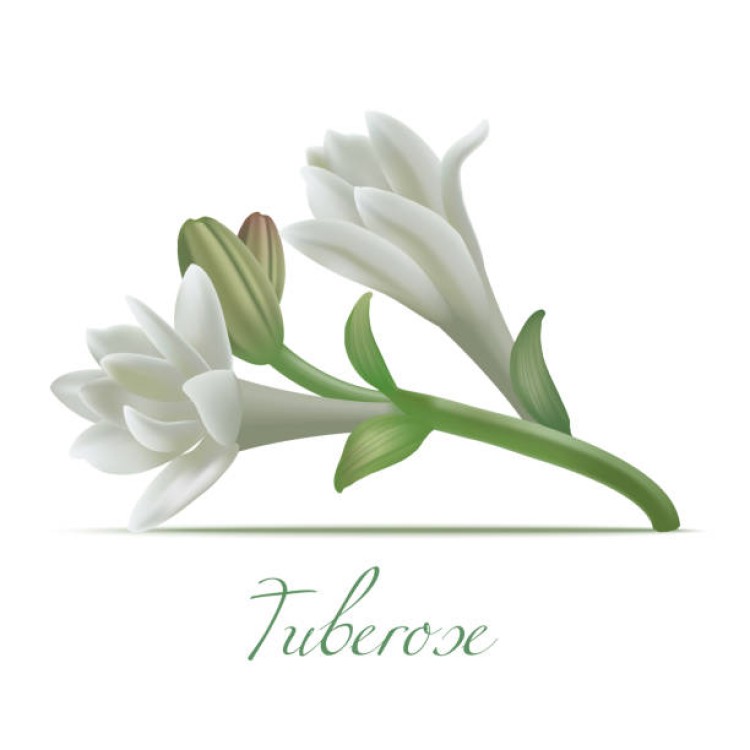
Tuberose (Polianthes tuberosa L.)is one of the most important tropical ornamental bulbous flowering plants cultivated for the production of long-lasting flower spikes. It is popularly known as Rajanigandha or Nishigandha. It belongs to the family Amaryllidaceae and is native to Mexico. Tuberose is an important commercial cut as well as a loose flower crop due to its pleasant fragrance, longer vase-life of spikes, higher returns, and wide adaptability to varied climates and soil. They are valued much by the aesthetic world for their beauty and fragrance.
Tuberose is a native of Mexico where it spread to different parts of the world during the 16th Century. This is one of the earliest cultivated plants and may be extinct in its natural habitat. The Aztecs were growing it nearly 600 years ago. The Spanish found the Aztecs growing it in 1519 and took it back with them to the old World. A French missionary, returning from the Indies in the 1500s did so as well. Once introduced to Europe, it became part of the moon garden, a collection of white or pastel flowers, which release an intense fragrance after dusk. These gardens were popular among the sun-shunning Victorian ladies, who valued a milky pale complexion. The plant did fall out of favor when it became much overused at funerals. It has an intense fragrance and one or two open blossoms will fill the air of an entire garden. It is believed that tuberose was brought to India via Europe in the 16th century.
Tuberose can successfully be grown in pots, borders, and beds and commercially cultivated for its various uses. The flowers of tuberose are also used for making artistic garlands, floral ornaments, bouquets, buttonholes, gajras, and extraction of essential oil. It is also a popular cut flower, not only for use in arrangements but also for the individual florets that can provide fragrance to bouquets and boutonnieres. The long flower spikes are excellent as cut flowers for table decoration. The flowers emit a delightful fragrance. Tuberose represents sensuality and is used in aromatherapy for its ability to open the heart and calm the nerves, restoring joy, peace, and harmony. Tuberose flowers have long been used in perfumery as a source of essential oils and aroma compounds. Tuberose oil is used in high-value perfumes and cosmetic products. Furthermore, fragrant flowers are added along with stimulants or sedatives to the favorite beverage prepared from chocolate and served either cold or hot as desired. Tuberose bulbs contain an alkaloid -lycorine, which causes vomiting. The bulbs are rubbed with turmeric and butter and applied as a paste over the red pimples of infants. Dried tuberose bulbs in powdered form are used as a remedy for gonorrhea. In Java, the flowers are eaten along with the juices of the vegetables.
Extraction of Concrete and Absolute
Tuberose flower is one of the flowers which continue to exude perfume long after it is removed from the plant. The flower oil is extracted by enfleurage and solvent extraction with petroleum ether.Freshly picked flowers, before they open, are enfleuraged. About 150 kg of flowers are needed to produce 1 kg of brown, semi- solid absolute of enfleurage which contains 11-15% of steam volatile oil.The extracted flowers will contain some natural perfume and are treated with petroleum ether to obtain the absolute of chassis as a valuable by-product (yield 1.2-1.5%). Tuberose Absolute is prepared from flowers which are picked immediately before they have opened. It requires 3600 pounds (1635 kg) of blossoms to produce 1 pound (454 g) of the absolute. Tuberose absolute is dark orange or brown in colour, with a heavy sweet floral sometimes slightly spicy, tenacious fragrance. In recent years, the process of Enfleurage has been partly replaced by solvent extraction, which requires much less labour though the yield of the absolute reduces considerably. Extraction of tuberose flowers with petroleum ether yields 0.08 – 0.14 per cent of concrete, which gives 18 – 23% of absolute on treatment with alcohol and contains 3 – 5% steam volatile oil. Out of the approximate total yield of 30,000 kg of loose flowers from one hectare, in three years, 27.5 kg of ‘concrete’ could be obtained.

|

|
Currently, there are no comment.
Login to comment